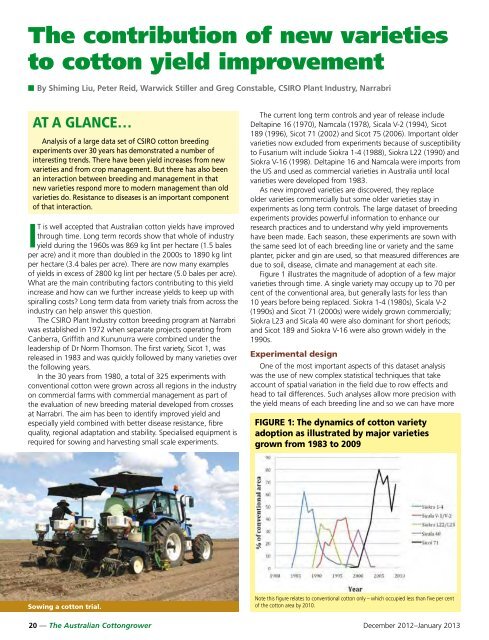cotton - Greenmount Press
cotton - Greenmount Press
cotton - Greenmount Press
You also want an ePaper? Increase the reach of your titles
YUMPU automatically turns print PDFs into web optimized ePapers that Google loves.
The contribution of new varieties<br />
to <strong>cotton</strong> yield improvement<br />
■ By Shiming Liu, Peter Reid, Warwick Stiller and Greg Constable, CSIRO Plant Industry, Narrabri<br />
AT A GLANCE…<br />
Analysis of a large data set of CSIRO <strong>cotton</strong> breeding<br />
experiments over 30 years has demonstrated a number of<br />
interesting trends. There have been yield increases from new<br />
varieties and from crop management. But there has also been<br />
an interaction between breeding and management in that<br />
new varieties respond more to modern management than old<br />
varieties do. Resistance to diseases is an important component<br />
of that interaction.<br />
IT is well accepted that Australian <strong>cotton</strong> yields have improved<br />
through time. Long term records show that whole of industry<br />
yield during the 1960s was 869 kg lint per hectare (1.5 bales<br />
per acre) and it more than doubled in the 2000s to 1890 kg lint<br />
per hectare (3.4 bales per acre). There are now many examples<br />
of yields in excess of 2800 kg lint per hectare (5.0 bales per acre).<br />
What are the main contributing factors contributing to this yield<br />
increase and how can we further increase yields to keep up with<br />
spiralling costs Long term data from variety trials from across the<br />
industry can help answer this question.<br />
The CSIRO Plant Industry <strong>cotton</strong> breeding program at Narrabri<br />
was established in 1972 when separate projects operating from<br />
Canberra, Griffith and Kununurra were combined under the<br />
leadership of Dr Norm Thomson. The first variety, Sicot 1, was<br />
released in 1983 and was quickly followed by many varieties over<br />
the following years.<br />
In the 30 years from 1980, a total of 325 experiments with<br />
conventional <strong>cotton</strong> were grown across all regions in the industry<br />
on commercial farms with commercial management as part of<br />
the evaluation of new breeding material developed from crosses<br />
at Narrabri. The aim has been to identify improved yield and<br />
especially yield combined with better disease resistance, fibre<br />
quality, regional adaptation and stability. Specialised equipment is<br />
required for sowing and harvesting small scale experiments.<br />
The current long term controls and year of release include<br />
Deltapine 16 (1970), Namcala (1978), Sicala V-2 (1994), Sicot<br />
189 (1996), Sicot 71 (2002) and Sicot 75 (2006). Important older<br />
varieties now excluded from experiments because of susceptibility<br />
to Fusarium wilt include Siokra 1-4 (1988), Siokra L22 (1990) and<br />
Siokra V-16 (1998). Deltapine 16 and Namcala were imports from<br />
the US and used as commercial varieties in Australia until local<br />
varieties were developed from 1983.<br />
As new improved varieties are discovered, they replace<br />
older varieties commercially but some older varieties stay in<br />
experiments as long term controls. The large dataset of breeding<br />
experiments provides powerful information to enhance our<br />
research practices and to understand why yield improvements<br />
have been made. Each season, these experiments are sown with<br />
the same seed lot of each breeding line or variety and the same<br />
planter, picker and gin are used, so that measured differences are<br />
due to soil, disease, climate and management at each site.<br />
Figure 1 illustrates the magnitude of adoption of a few major<br />
varieties through time. A single variety may occupy up to 70 per<br />
cent of the conventional area, but generally lasts for less than<br />
10 years before being replaced. Siokra 1-4 (1980s), Sicala V-2<br />
(1990s) and Sicot 71 (2000s) were widely grown commercially;<br />
Siokra L23 and Sicala 40 were also dominant for short periods;<br />
and Sicot 189 and Siokra V-16 were also grown widely in the<br />
1990s.<br />
Experimental design<br />
One of the most important aspects of this dataset analysis<br />
was the use of new complex statistical techniques that take<br />
account of spatial variation in the field due to row effects and<br />
head to tail differences. Such analyses allow more precision with<br />
the yield means of each breeding line and so we can have more<br />
FIGuRE 1: The dynamics of <strong>cotton</strong> variety <br />
adoption as illustrated by major varieties <br />
grown from 1983 to 2009<br />
Sowing a <strong>cotton</strong> trial.<br />
Note this figure relates to conventional <strong>cotton</strong> only – which occupied less than five per cent<br />
of the <strong>cotton</strong> area by 2010.<br />
20 — The Australian Cottongrower December 2012–January 2013

















